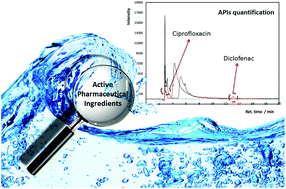当前位置:
X-MOL 学术
›
Green Chem.
›
论文详情
Our official English website, www.x-mol.net, welcomes your
feedback! (Note: you will need to create a separate account there.)
Improved monitoring of aqueous samples by the preconcentration of active pharmaceutical ingredients using ionic-liquid-based systems
Green Chemistry ( IF 9.3 ) Pub Date : 2017-08-29 00:00:00 , DOI: 10.1039/c7gc01954h Hugo F. D. Almeida 1, 2, 3, 4, 5 , Mara G. Freire 4, 5, 6, 7, 8 , Isabel M. Marrucho 1, 2, 3, 4, 9
Green Chemistry ( IF 9.3 ) Pub Date : 2017-08-29 00:00:00 , DOI: 10.1039/c7gc01954h Hugo F. D. Almeida 1, 2, 3, 4, 5 , Mara G. Freire 4, 5, 6, 7, 8 , Isabel M. Marrucho 1, 2, 3, 4, 9
Affiliation

|
Fluoroquinolones (FQs) and Non-Steroidal Anti-Inflammatory Drugs (NSAIDs) are two classes of Active Pharmaceutical Ingredients (APIs) in widespread use in human healthcare and as veterinary drugs, and that have been found throughout the water cycle in the past years. These two classes of APIs are commonly present in aqueous streams in concentrations ranging from ng L−1 to μg L−1. Despite such low concentrations, these contaminants tend to bioaccumulate, leading to serious environmental and health issues after chronic exposure. The low concentrations of FQs and NSAIDs in aqueous media also render difficult identification and quantification, which may result in an inefficient evaluation of their environmental impact and persistence. Therefore, the development of alternative pre-treatment techniques for their extraction and preconcentration from aqueous samples is a crucial requirement. In this work, liquid–liquid systems, namely ionic-liquid-based aqueous biphasic systems (IL-based ABS), were tested as simultaneous extraction and preconcentration platforms for FQs and NSAIDs. ABS composed of imidazolium-, ammonium- and phosphonium-based ILs and a citrate-based salt (C6H5K3O7) were evaluated for the single-step extraction and enrichment of three FQs (ciprofloxacin, enrofloxacin and norfloxacin) and three NSAIDs (diclofenac, naproxen and ketoprofen) from aqueous samples. Outstanding one-step extraction efficiencies of APIs close to 100% were obtained. Furthermore, the preconcentration factors of both FQs and NSAIDs were optimized by an appropriate manipulation of the phase-forming components compositions to tailor the volumes of the coexisting phases. Preconcentration factors of 1000-fold of both FQS and NSAIDs were obtained in a single-step process, without reaching the saturation of the IL-rich phase. The preconcentration of APIs up to mg L−1 allowed their easy and straightforward identification and quantification by a High-Performance Liquid Chromatography (HPLC) system coupled to an UV detector, as shown for both model systems (distilled water) and real effluent samples from a wastewater treatment plant.
中文翻译:

使用基于离子液体的系统对活性药物成分进行预浓缩,从而改善了对水样的监测
氟喹诺酮类(FQs)和非甾体抗炎药(NSAIDs)是在人类医疗保健和兽药中广泛使用的两类活性药物成分(API),并且在过去几年的整个水循环中都被发现。这两类API通常以ng L -1至μgL -1的浓度存在于水流中。尽管浓度如此之低,但这些污染物仍会生物累积,导致慢性暴露后导致严重的环境和健康问题。水性介质中FQ和NSAID的低浓度也使鉴定和定量变得困难,这可能导致对其环境影响和持久性的评估效率低下。因此,开发用于从含水样品中提取和预浓缩的替代预处理技术至关重要。在这项工作中,测试了液-液系统,即基于离子-液体的水性双相系统(基于IL的ABS)作为FQ和NSAID的同时提取和预浓缩平台。ABS由基于咪唑鎓,铵鎓和IL的IL和基于柠檬酸盐的盐(C 6 H 5K 3 O 7)用于从含水样品中一步纯化和富集三个FQ(环丙沙星,恩诺沙星和诺氟沙星)和三个NSAID(双氯芬酸,萘普生和酮洛芬)的步骤。获得了接近100%的出色的API一步提取效率。此外,通过适当地控制相形成组分的组成来调整共存相的体积,可以优化FQ和NSAID的预浓缩因子。仅一步即可获得FQS和NSAID的1000倍的预浓缩因子,而不会达到富含IL的相的饱和度。API的预浓缩至mg L -1 通过与紫外检测器相连的高效液相色谱(HPLC)系统,可以轻松,直接地进行鉴定和定量分析,如模型系统(蒸馏水)和废水处理厂的实际废水样品所示。
更新日期:2017-09-11
中文翻译:

使用基于离子液体的系统对活性药物成分进行预浓缩,从而改善了对水样的监测
氟喹诺酮类(FQs)和非甾体抗炎药(NSAIDs)是在人类医疗保健和兽药中广泛使用的两类活性药物成分(API),并且在过去几年的整个水循环中都被发现。这两类API通常以ng L -1至μgL -1的浓度存在于水流中。尽管浓度如此之低,但这些污染物仍会生物累积,导致慢性暴露后导致严重的环境和健康问题。水性介质中FQ和NSAID的低浓度也使鉴定和定量变得困难,这可能导致对其环境影响和持久性的评估效率低下。因此,开发用于从含水样品中提取和预浓缩的替代预处理技术至关重要。在这项工作中,测试了液-液系统,即基于离子-液体的水性双相系统(基于IL的ABS)作为FQ和NSAID的同时提取和预浓缩平台。ABS由基于咪唑鎓,铵鎓和IL的IL和基于柠檬酸盐的盐(C 6 H 5K 3 O 7)用于从含水样品中一步纯化和富集三个FQ(环丙沙星,恩诺沙星和诺氟沙星)和三个NSAID(双氯芬酸,萘普生和酮洛芬)的步骤。获得了接近100%的出色的API一步提取效率。此外,通过适当地控制相形成组分的组成来调整共存相的体积,可以优化FQ和NSAID的预浓缩因子。仅一步即可获得FQS和NSAID的1000倍的预浓缩因子,而不会达到富含IL的相的饱和度。API的预浓缩至mg L -1 通过与紫外检测器相连的高效液相色谱(HPLC)系统,可以轻松,直接地进行鉴定和定量分析,如模型系统(蒸馏水)和废水处理厂的实际废水样品所示。









































 京公网安备 11010802027423号
京公网安备 11010802027423号